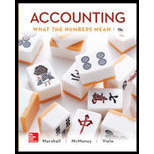
Concept explainers
Concept Introduction:
Variable costing: Variable costing is one of the methods of calculation of product costs. Under this method, only the variable
Absorption costing: Absorption costing is one of the methods of calculation of product costs. Under this method, the fixed manufacturing
Requirement-a:
To Calculate:
The cost per order using the variable and absorption costing methods
Concept Introduction:
Variable costing: Variable costing is one of the methods of calculation of product costs. Under this method, only the variable manufacturing costs are considered as part of the product cost. Under this method, the income statement calculates contribution margin and net operating income.
Absorption costing: Absorption costing is one of the methods of calculation of product costs. Under this method, the fixed manufacturing overheads are also considered as part of the product cost with direct costs. The unit product cost includes direct material, direct labor, and variable overhead and allocated amount of fixed overhead. Under this method, the income statement calculates Gross margin and net operating income.
Requirement-b:
To Calculate:
The difference in the operating incomes under variable and absorption costing method if there were 4200 units in the ending inventory
Concept Introduction:
Variable costing: Variable costing is one of the methods of calculation of product costs. Under this method, only the variable manufacturing costs are considered as part of the product cost. Under this method, the income statement calculates contribution margin and net operating income.
Absorption costing: Absorption costing is one of the methods of calculation of product costs. Under this method, the fixed manufacturing overheads are also considered as part of the product cost with direct costs. The unit product cost includes direct material, direct labor, and variable overhead and allocated amount of fixed overhead. Under this method, the income statement calculates Gross margin and net operating income.
Requirement-c:
To Calculate:
The cost formula for orders and total cost for additional 500 units
Want to see the full answer?
Check out a sample textbook solution
Chapter 13 Solutions
Accounting: What the Numbers Mean
- Three individuals form JEY Corporation with the following contributions: Joe, cash of $50,000 for 50 shares; Ethan, land worth $20,000 (basis of $11,000) for 20 shares; and Young, cattle worth $9,000 (basis of $6,000) for 9 shares and services worth $21,000 for 21 shares. a. These transfers are fully taxable and not subject to § 351. b. Young’s basis in her stock is $27,000. c. Young’s basis in her stock is $6,000. d. Ethan’s basis in his stock is $20,000. e. None of the above.arrow_forwardNonearrow_forwardaccounting?arrow_forward
- Can you help me solve this general accounting question using valid accounting techniques?arrow_forwardCan you help me solve this general accounting problem using the correct accounting process?arrow_forwardI need help with this general accounting question using the proper accounting approach.arrow_forward

 AccountingAccountingISBN:9781337272094Author:WARREN, Carl S., Reeve, James M., Duchac, Jonathan E.Publisher:Cengage Learning,
AccountingAccountingISBN:9781337272094Author:WARREN, Carl S., Reeve, James M., Duchac, Jonathan E.Publisher:Cengage Learning, Accounting Information SystemsAccountingISBN:9781337619202Author:Hall, James A.Publisher:Cengage Learning,
Accounting Information SystemsAccountingISBN:9781337619202Author:Hall, James A.Publisher:Cengage Learning, Horngren's Cost Accounting: A Managerial Emphasis...AccountingISBN:9780134475585Author:Srikant M. Datar, Madhav V. RajanPublisher:PEARSON
Horngren's Cost Accounting: A Managerial Emphasis...AccountingISBN:9780134475585Author:Srikant M. Datar, Madhav V. RajanPublisher:PEARSON Intermediate AccountingAccountingISBN:9781259722660Author:J. David Spiceland, Mark W. Nelson, Wayne M ThomasPublisher:McGraw-Hill Education
Intermediate AccountingAccountingISBN:9781259722660Author:J. David Spiceland, Mark W. Nelson, Wayne M ThomasPublisher:McGraw-Hill Education Financial and Managerial AccountingAccountingISBN:9781259726705Author:John J Wild, Ken W. Shaw, Barbara Chiappetta Fundamental Accounting PrinciplesPublisher:McGraw-Hill Education
Financial and Managerial AccountingAccountingISBN:9781259726705Author:John J Wild, Ken W. Shaw, Barbara Chiappetta Fundamental Accounting PrinciplesPublisher:McGraw-Hill Education





